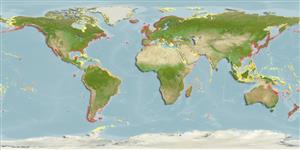Polychaeta |
Canalipalpata |
Oweniidae
Environment: milieu / climate zone / ระดับความลึก / distribution range
นิเวศวิทยา
; กร่อย; ระดับความลึก 3 - 237 m (อ้างอิง 112705). Tropical
Indo-West Pacific, Atlantic Ocean, Arctic and the Mediterranean.
Length at first maturity / ขนาด / Weight / Age
วัยเจริญพันธุ์: Lm ? range ? - ? cm Max length : 10.0 cm TL เพศผู้/กระเทย; (อ้างอิง 7882)
Species' maximum length from the Belgian part of the North Sea (Ref. 7882). Length based from occurrence record; to be replaced with better reference. Maximum depth from Ref. 117328. Inhabits sandbanks and muddy bottoms of estuaries and inshore areas (Ref. 96352) and along the near-coastal zone. A tube-dwelling bristle worm, preferring fine to coarse sediment with 10 to 40% mud content. Its flexible tube, longer than the worm itself and made up of cemented sand grains and shell fragments, allows it to withdraw inward and the tube to subsequently bend down (Ref. 7882). A filter- and suspension feeder (Ref. 75621). Capable of surface deposit feeding (Ref. 87179). Feeds on organic detritus (Ref. 96352) and small invertebrates (Ref. 87179).
Life cycle and mating behavior
วัยเจริญพันธุ์ | การสืบพันธุ์ | การวางไข่ | Eggs | ความดกของไข่ | Larvae
Members of the class Polychaeta are mostly gonochoric (sexual). Mating: Females produce a pheromone attracting and signalling the males to shed sperm which in turn stimulates females to shed eggs, this behavior is known as swarming. Gametes are spawned through the metanephridia or body wall rupturing (termed as "epitoky", wherein a pelagic, reproductive individual, "epitoke", is formed from a benthic, nonreproductive individual, "atoke"). After fertilization, most eggs become planktonic; although some are retained in the worm tubes or burrowed in jelly masses attached to the tubes (egg brooders). Life Cycle: Eggs develop into trocophore larva, which later metamorph into juvenile stage (body lengthened), and later develop into adults.
López-Jamar, E., G. González and J. Mejuto 1986 Temporal changes of community structure and biomass in two subtidal macroinfaunal assemblages in La Coruña bay, NW Spain. Hydrobiologia 142:137-150. (อ้างอิง 2778)
IUCN Red List Status
(อ้างอิง 130435: Version 2025-1)
CITES status (อ้างอิง 108899)
Not Evaluated
CMS (อ้างอิง 116361)
Not Evaluated
Threat to humans
Human uses
| FishSource |
เครื่องมือ
ข้อมูลเพิ่มเติม
Life cycleการสืบพันธุ์วัยเจริญพันธุ์ความดกของไข่การวางไข่EggsEgg developmentLarvae Human RelatedStamps, coins, misc.
แหล่งที่มาจากอินเตอร์เน็ต
Estimates based on models
Preferred temperature
(Ref.
115969): 1.9 - 17.3, mean 7.3 (based on 218 cells).
Fishing Vulnerability
Low vulnerability (10 of 100).
Price category
Unknown.
